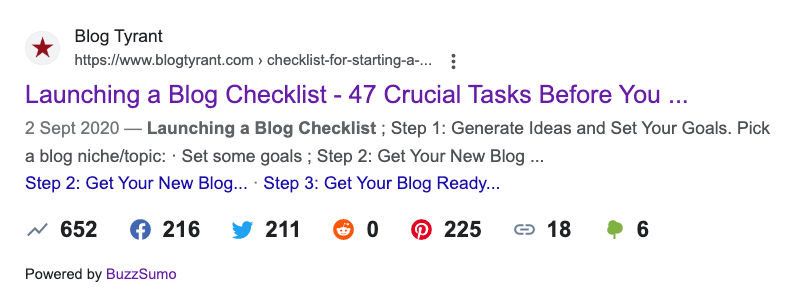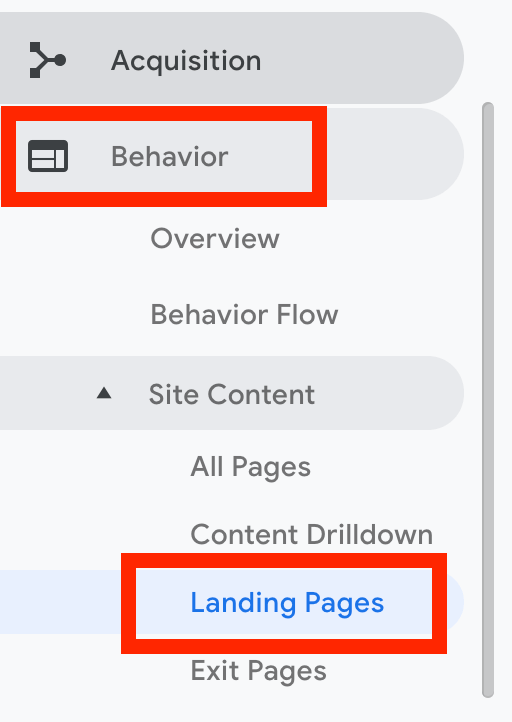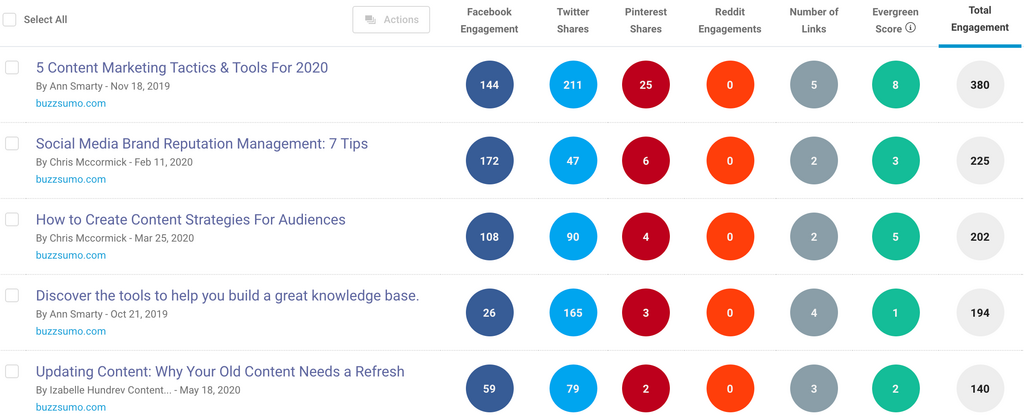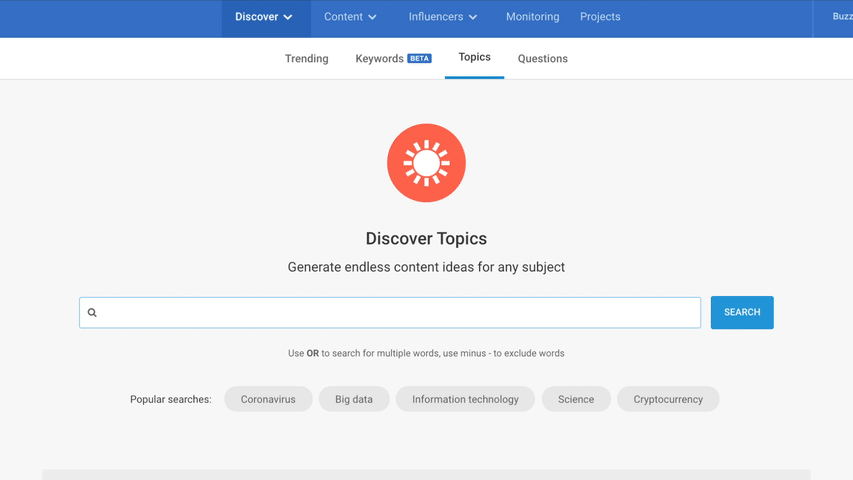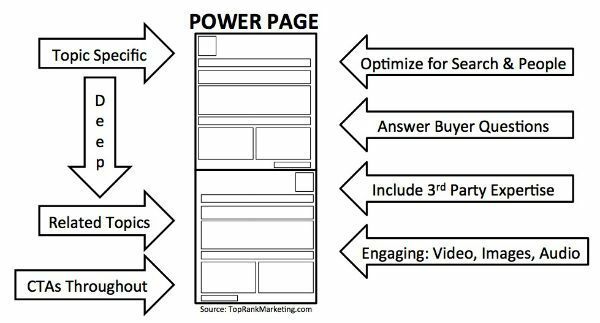Published March 13th 2023
91+ Blog Post Ideas Driven By Data & Examples
The business of content marketing is the business of ideas. Blog post ideas, newsletter ideas, ideas for courses or whitepapers – we need them all.
And we need a lot of them!
Below are 91+ blog post ideas, compiled over the last year, to get your creative juices flowing...
And to find out how to check the engagement of your blog post ideas, jump to this section:
How to verify whether your blog post ideas are worth creating
1. Play into an audience fear
Ask a question of your reader that underscores one of their greatest fears, and then allay that fear within the blog by offering the solution.
From a neurological perspective, negative words in headlines lead to more clicks, according to Neuroscience and SEO expert Giulia Panozzo, but be very careful to avoid clickbait.
2. Offer a hypothetical or write a ”What if” post
Comment on the wider industry with a op-ed / think-piece, like this one “What if there were no Google?”, or inspire readers with novel possibilities.
3. Create tool battle cards with “vs.” posts
Compare your product or service against competitors.
This defensive content strategy will allow you to say your piece against your top rivals, and highlight your USPs.
4. Compare two competitors and insert your brand into the conversation
This is a great tip from content expert Chima Mmeje.
Rather than trash talking competitors, focus on capturing the branded traffic of two of your competitors, by comparing their relative merits and disadvantages.
Then bring the conversation back to your own brand, and sell your offering in the conclusion.
Chima gives this blog on HelloSign vs. Docusign, by Pandadoc, as a brilliant example of this.
But you can also do this for brands you have some affiliation with.
For example, Zapier writes about the tools that it integrates with, as a vehicle for promoting its own services.
5. Put forward a provocative opinion or challenge a common belief
Another blog post idea that creates clicks is the “Controversial opinion”. Going against the grain is a great way to entice audiences to read on.
In the example from SparkToro below, Rand Fishkin challenges the whole notion of marketing attribution; a practice that many marketers swear-by for measuring success.
This headline makes readers want to click to find out exactly “How” they can report on success without attribution.
Pro Tip
Get inspiration from content causing strong reactions
If a piece of content has been particularly controversial or surprising, you can bet that audiences will show that in their reactions.
BuzzSumo lets you hone in on the content generating the most reactions on Facebook.
Just search your topic in the Content Analyzer, hit the Content Analysis Report view, and scroll for a chart of dominant Facebook reactions.
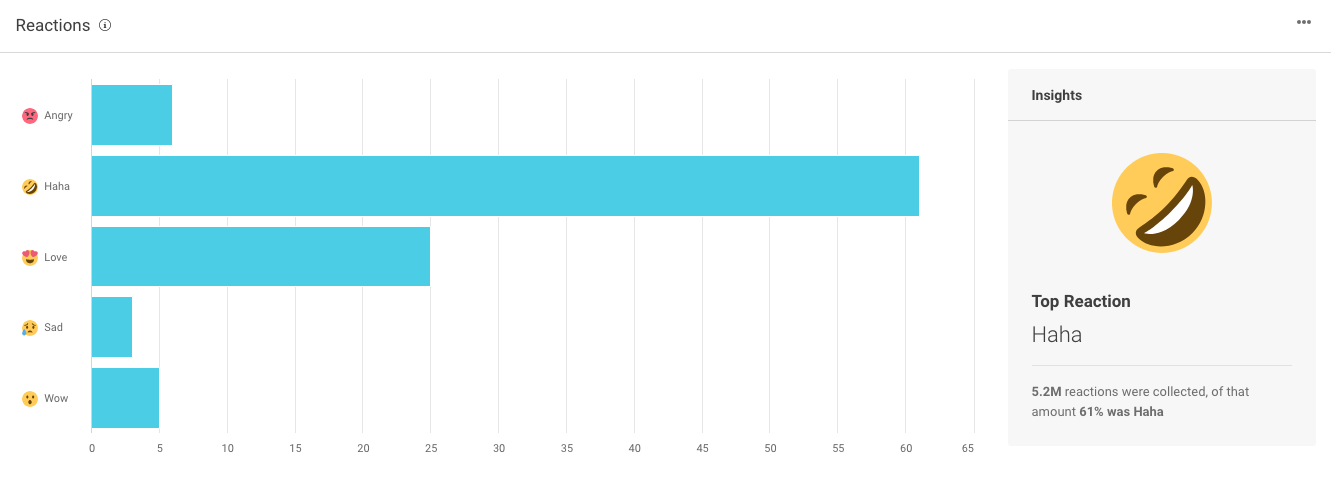
Or dive-deeper into specific reactions. Simply sort by a specific Facebook reaction, to see which content received the most-to-least reactions…
Or filter to deep-dive into the content behind just one type of reaction…
6. Showcase “A day in the life”
Put someone in the hot seat.
Interview them on what a typical day looks like in their role. It could be an industry professional, a thought leader, a celeb – even you.
7. Create a stat-driven case study
Impressive stats pique our interest. Create a case study that makes readers want to click, with a stat that packs a punch.
We did just this in our Rise at Seven case study.
And for extra inspiration, read this awesome piece by Ryan Darani.
8. Curate your case studies
From an SEO perspective, this blog post idea is on-point. Often case study landing pages lack the right amount of detail to rank for competitive keywords.
Curating a list of your best case studies in blog form can help you not only promote your product / service, but also reach the heady heights of page one in the SERPs.
This is a great example from Fractl, which is helping them to rank in position #1 (at the time of writing) for the keyword “content marketing case studies” which gets searched 700 times /month globally.
9. Curate first and third party statistics
According to our study of three million B2B content marketing examples, statistics posts are most likely to drive big links, and this blog from Ahrefs is no exception.
Many blog post idea articles suggest creating statistics blogs, but we suggest curating both externally AND internally so that your blog post acts as an internal link repository.
10. Link two seemingly unrelated concepts
Draw comparisons between your topic and an unassociated, novel, or taboo topic.
This is another great click-driving technique.
Audiences will be desperate to know how these two seemingly unrelated topics are connected.
Use headline phrases like "What X taught me about Y" or "How X made me a better Y".
11. Create first-party original research
This is a heavier-lift blog post idea, but a proven way to drive shares, links, and traffic.
ChatGPT has democratized the creation of content and made it easy for anyone to blog, but there’s still no real replacement for first-hand, original research.
That’s because you’re creating unique theories and hypotheses with data.
At BuzzSumo, we specialize in original research, and work on multiple studies a year, including this analysis of 600K journalists.
12. Create useful Google Sheets formulas
Do you have a nifty process in Google Sheets or excel that might be handy for your audience to know?
Write a blog post outlining your Sheet hacks, and embed your template for your audience to use.
This kind of blog idea has become increasingly popular recently, especially in PR and Marketing.
In fact we worked with Digital PR, Tom Chivers, on a webinar to showcase the best PR formulas for outreach using BuzzSumo.
Check out this handy blog from co-schedule for more PR strategy examples.
13. Create an ultimate guide
Everyone has heard of the ultimate guide. Take a subject you’re well-versed in and go to town explaining it.
Include commonly asked / searched FAQs, definitions that give you more chance of visibility in the SERPs, and tutorial-like step-by-steps complete with examples.
14. Curate expert opinions and guidance
Expert compilations have been a hit for a while, but some rely heavily on the contributors’ audiences to make them work.
We recommend adding value to expert input, rather than relying on it.
What's good about Aira's yearly contributor reports is that they’re a mix of real research, analysis, and expert opinions.
This means that the influencer's point of view adds to the content, rather than being the sole focus.
15. Write an open letter
Open letters usually take the recipient to task on a specific issue.
The public nature of an open letter attracts attention in the same way a school tussle draws a crowd.
Use this type of blog post only if you have something worth saying.
And be mindful that this kind of content can divide opinion.
16. Carry out an experiment and report on the outcome
Conducting an experiment, and taking your reader along for the ride, is a great way to build loyal audiences.
Complete with scene-setting, a hypothesis, methodology, and first and third-person chronological accounts, this experiment by Reboot Online does just that.
17. Repurpose social media content
Whether it’s a Twitter thread or LinkedIn discussion, use social media activity as inspiration for your next blog post idea.
The PR Measurement guide below was written by Digital PR Expert Stephen Waddington, and began life as a Twitter discussion.
The chat piqued our interest at BuzzSumo HQ, and so we reached out to Stephen and asked him if he’d be interested in guest posting his ideas on our blog.
18. Spotlight a feature in your product
Highlight a new feature, including its benefits and use cases, to help your users get going.
19. Draw up actionable tips
Focus on sharing genuinely useful tips that your audience can actually act upon.
Too many blogs are filled with fluff, and nebulous advice.
Give your reader some incredibly specific tips that they can’t help but test-drive.
This blog post idea is also a great way to drive traffic to your site since “Topic + tip” keyword combinations are usually popular searches.
Take this list from Ahrefs.
Not only does it perfectly combine tactical tips with sage strategic advice, it also ranks in position two for the keyword “Marketing tips”, which drives a cool 6.3K searches a month globally.
And to date it has driven hundreds of engagements online...
20. Create a TL;DR listicle
For your next blog post idea, consider those who are strapped for time.
Creating a TL;DR listicle gives them the chance to scan the need-to-knows, and gives you the chance to sell-in on the value of your content.
Get to the heart of what you want to say, just like SEMRush did in this article.
They begin with an infographic of a TL;DR checklist, and dig into the detail below.
You can do the same with a summary section at the top of your blog, or even just a contents!
21. Create a chronological checklist
Similar to the blog post idea above, think about creating a methodical checklist style blog.
Don’t scrimp on the detail.
Walk your audience through a project or task minute-by-minute, and help them get the job done correctly.
22. Unpick viral trends
Ride the engagement wave of viral trends.
Pick apart the topic, and analyze why everyone can’t stop talking about it.
Cleveland Health Clinic did just this when TikTokers began slathering their faces with petroleum jelly as part of a trend called “Slugging”.
Their informative guide has earned them pretty respectable levels of engagement.
23. Create brand success teardowns
Reverse engineer the success of brands in your industry, to provide inspiration for your audience.
Foundation Inc does this brilliantly in their lab.
24. Turn publicly available information into headlines
A tactic of the most elite PRs in the game, this blog post idea can get you earning big press coverage.
Simply find some publicly available data, and slice and dice it until you find a unique angle for writing and pitching to journalists.
In the example below, the Stacker team used "various news and scientific sources, [to compile] a list of 23 astronomical events to observe in 2023."
Publicly available information is available in all forms and varieties.
Check out this blog on open data from G2 for ideas of public data that you can tap into.
25. Showcase industry insights via infographics
Bring the data and insights in your blog to life with an infographic.
According to our own B2B research, infographics are likely to generate a higher than average amount of links, and this example from Haiilo on employee engagement statistics is no exception, as it’s earned an impressive 100 backlinks.
26. Predict trends for the year ahead
Research the current developments in your niche, and have a go at envisaging how those might play out over the coming year.
This is a great end-of-year piece to engage audiences, and give your December numbers a bump.
To enrich your predictions, try involving other experts.
We did just this in our piece on content trends for agencies.
And here’s another example of an engaging post following this format…
27. Interview an industry expert
Do a deep-dive interview with a person of interest in your sector or industry.
Capture the interest of their fans (or foes), and benefit from that ready-made engagement.
28. Create a glossary of industry terms
Although it may sound uninspired, creating a glossary or dictionary of common terms used in your field is a great way to become a regular reference point for your audience.
That means continuous traffic and sustained brand awareness – not to mention the SEO benefits.
Creating a glossary gives you an extra chance at SERP visibility, since your blog post is more likely to feature in rich SERP snippets.
29. Tell your audience “Why” something is important
In our study of 100 million headlines, the article titles featuring the word “Why” or, more specifically the phrase: “Why you need” fared incredibly well at generating engagement.
Why? 😉 Because they invoke urgency and create a sense of FOMO.
They are imperative statements that:
- Clearly instruct readers
- Imply that crucial information is contained within, and…
- Reassure readers that the blog will enlighten them
30. Visualize data in map form
If your blog has a geographical angle, try creating a map visualization to bring your insights to life.
31. Create useful industry tools
Consider solving your customers’ pain points with a genuinely useful tool.
We found that free tools generate by far the most links out of all B2B content types.
This nifty content marketing ROI calculator from Siege Media fits the bill.
32. Discuss common industry mistakes
Give your audience some examples of mistakes in your niche, and outline the main learnings, to help them avoid the same pitfalls.
33. Share your own mistakes
Get personal. Share the hardest lessons you’ve had to learn in your field.
First person accounts make your blog posts all that more relatable, and are a great way to build a loyal audience.
34. Detail the “History of” a topic
For a simple blog idea, simply document the history of a topic your audience cares about.
35. Repurpose podcast content through transcription
Get extra mileage out of different content formats. Turn your podcasts into blog post transcripts.
The great thing about doing this is, not only are you making your content more accessible for those unable to listen, but you’re also opening it up to search engine crawlers, which help you to rank and drive more traffic.
36. Curate “Best of *year*” content
Give your reader a run-down of the top-tier topics in your niche, and offer your superlative recommendations.
37. Curate a “Jealousy” list
Curate the ideas you wish you’d thought of, and detail their genius.
38. Do a year-in-review
Hey, if it’s good enough for the likes of Spotify and Google, then it’s good enough for you.
Look back on the ups and downs of the year in relation to your sector or niche.
39. Sell the problem more than the solution
Hands up 🙌 We nabbed this idea from Gisele Navarro at NeoMam Studios.
Define your customers’ biggest problems, and devise your blog content around it.
This way you can seamlessly surface your brand as the solution.
Here’s a great example from NeoMam.
40. List top resources for your industry
Compile the most useful resources for your audience, and keep them coming back for great recommendations.
Resources to recommend:
- Events
- Movies
- Podcasts
- Experts
- Talks
- Creators
- Music
- Playlists
- Books
- Products / services / tools
- Videos
- Blogs
- Channels
41. Write about an influencer/experts’ process
Pick the brains of those considered successful in your field.
Dig into their processes and habits, to help your reader replicate the wins of those they admire.
42. Create then and now content
This blog post idea helps you demonstrate the evolution of something or someone.
That could be a person your audience is familiar with now, vs. their younger, less successful counterpart.
Or it could be the evolution of brands, products, content – you name it.
These blog posts are perfect for driving curiosity clicks and engagements
43. Repurpose by summarizing your video content
Extend the engagement of your video content to your blog.
Summarize the key takeaways of your latest webinar or video explainer, alongside your embedded content.
44. Create tribe-focused “Quiz” content
Keep your readers engaged with this interactive blog idea.
Once wildly popular in the hey-day of clickbait, quiz content enables audiences to find their “tribe” and discover more about themselves.
It’s great brand awareness content, since it’s wildly shareable.
45. Coin a new theory
Coin an entirely new theory or name an established, but little-known concept.
The great thing about this blog idea is that whenever your theory is mentioned you’ll know, unequivocally, that it’s due to your content.
The team at SparkToro did just this.
They coined the term “Zero click content” to describe how social platforms reward posts with native content over posts featuring external links.
This concept was already known, but went unnamed until SparkToro coined the phrase and took it on tour.
Now it’s common marketing lingo.
46. Create content with a sense of urgency
Give your audience a clear directive in your blog post, to put the onus on them to read.
A great example of this is featuring a deadline in your headline 😉
The blog post below uses the deadline “Right now” to reinforce that urgency. It’s also a great example of “Rulebook” content.
AnNo one wants to be actively getting things “Wrong”, so giving your reader a rulebook to live or work by is another great blog post idea.
47. Build FAQ content
This extremely referenceable blog post type will have you earning links for years, according to our own B2B content research.
Dive into your customer conversations in chatbots, over email, and during demos to create FAQ content that answers their most pressing questions.
48. Debunk industry myths
This is similar in style to #4 “Put forward a provocative opinion / challenge a common belief”.
You want to find a piece of advice that’s commonly imparted on your audience, and cross-examine to see whether it holds up.
Your ultimate aim should be to provide your reader with more useful and reliable information that they might never have considered.
49. Share your obsessions
Enthusiasm is infectious. For your next blog post idea, write about your latest passion project, product, or person.
50. Analyze survey results
Whether it’s a LinkedIn poll, or a thousand-person incentivized study, survey your target audience, and then report your findings back to them.
Highlight your key results, including the most unique findings, at the top of the blog.
51. Repurpose the main points of an eBook
eBooks drive significant shares and engagement.
If you’ve created an eBook in the past, capture new interest by giving new readers a sneak peek at some of the top takeaways.
52. Compile a list of inspiring ideas
You’ve come to this post for blog inspiration.
By now hopefully you’re feeling suitably inspired? 😉
Well now’s your chance to pay it forward.
Catalogue some top ideas to get your audience’s cogs whirring 🧠 ⚙️ and help them with their own innovations.
If you’re stuck for quality examples, just do what we do, and dive into BuzzSumo’s Content Analyzer.
53. Compile examples of what not to do
On the flip side, your blog post idea might be providing negative inspiration.
In other words, show your reader the limitations in their field, and outline what they need to avoid doing in order to be successful.
You never know. This might be just the kind of creative capital they need to dream up their next big idea.
54. List examples of hilarious blunders
Give your reader a bit of light-relief with examples of funny mishaps and in-jokes within their niche or industry.
55. Create a step-by-step tutorial
Give your audience a full blow-by-blow of a challenging concept.
56. List out novel ways of using something
Center your product or service, or a topic related to your niche, and highlight untapped use cases.
Make sure you shed light on any hidden easter eggs.
These have the power to seriously impress your readers.
57. Share something you wish you knew at the start of your career
Hindsight is 20:20. Looking back, is there anything you would have done differently when you first started out? Share this sage advice with your readers.
58. Report on an industry development
Keep your readers in the know by covering news as it breaks in your niche.
59. Offer free templates
Give practically useful templates to support your blog content, and help your audience take the steps to actually act on your advice.
60. Address your audience in your headline
Speak directly to your audience. Make it unmistakable that your content is for them, and then help them solve some of their biggest pain points.
61. Round-up relatable in-jokes
Curating (good) in-jokes shows your audience that you understand the realities of their world. This is a great way to build community.
62. Give your audience a peek behind the scenes
Show your fans how the sausage is made. Give them a never-before-seen look at how things work behind the scenes of a topic or project they care about.
63. Unpick failings or fads
Is something passé? Say it. Did a highly-anticipated event or development fall flat? Call it out, and give your hot take.
The mention of a fad or trend will prick the ears of your reader, and the suggestion of a failure will have them clicking to find out why.
64. Compile the funniest memes
Give your reader a giggle with some niche-relevant memes.
Create a blog they’ll read on their lunch break, or when they’re taking five.
This will help you create positive associations with your brand, and raise awareness.
65. Share what you and/or your company stand for
Share your company’s core values, and explain your rationale for embracing those values.
This is an example of brand reassurance content.
You want to show your audience that you’ve paid due care and attention to the things that are important to them – so much so that you’ve built those things into your business.
Warning: This kind of blog post idea should only be pursued if you have already identified and embraced these issues within your company ethos.
Creating a blog before you instil those values into your brand will be noticeably inauthentic.
66. Talk through your process
So many blog posts profess to show you “How to” do something, but more often than not, the headline has missold the content.
You expect clear and actionable to-dos, but instead you get vague, overly-simplified directives or, even more commonly, a blog on what you “Should” be doing rather than “How to” actually do it.
When we write content at BuzzSumo, we try – as much as possible – to practice what we preach, and make sure the advice we’re giving is actionable and based on personal experience.
Someone else who does that brilliantly is Erica Schneider, Head of Content at Grizzle.io.
The below isn’t an example of a blog, but could easily be one.
Erica walks readers through her process in an “Edit with me” based Twitter thread.
We recommend bookmarking this one.
67. Bare all with revenue and growth stats
If you’re committed to transparency, a great blog post idea is to share your growth stats and financial performance.
Involving your audience in your growth journey is a great way to build a community.
You’re letting them in on something that is usually kept under wraps, and inviting them to invest not just financially, but emotionally.
The more you share, the more your audience will be inclined to back you – especially if you started off as the underdog.
68. Curate hacks for your audience
Have you found some hidden gem hacks that your audience will benefit from hearing? List them out, and share your inspiration.
69. Spotlight product easter-eggs and hidden features
If you’ve discovered some genius yet well-hidden use cases within your own product, bring them to the fore in a listicle blog.
70. Cover an event
Whether you’re doing a rundown of the day’s events, or creating THE ultimate event guide packed full of tips and tricks, hijack ready-engaged audiences and tap into the ready-made awareness created during an event.
71. Document your campaign/project and write a wash-up
Gain the respect of your audience by letting them in on your winning processes. Take them through what worked, why it worked, and your learnings.
72. Write a review
Share your honest opinion on a product or service you’ve used recently.
Audiences crave unbiased views, and transparency – that’s why so many prospective customers now defer to Reddit over Google for real recommendations.
If you are paid or remunerated in any way for your review, be upfront about that from the outset.
And if you are reviewing out of the goodness of your heart, be sure to stress that and use it as a USP in your review – maybe even include it in the headline! Ie: My Unpaid, Unbiased Review Of BuzzSumo
73. Try out a trend and document your findings
This blog post idea falls into the category trendjacking. It’s essentially reviewing a trending product, service, or fad.
74. Share an amusing anecdote and your learnings
Let your readers into your world.
Centering yourself as a real person and not just a faceless brand makes it a lot easier for your readers to empathize with and trust you – and sharing your mistakes makes you even more relatable.
Weave a teachable moment into a funny anecdote, and you’ll have your audience gripped.
75. Write up a talk, presentation, or webinar you gave
Upcycle your talks and presentations, and get more mileage out of existing content.
76. Share a personal struggle, and how you overcame it
Being candid and honest about your struggles, especially in an industry or niche where you’re usually required to uphold a veneer of professionalism, makes for a refreshing read and can help your blog post stand out.
At BuzzSumo we wanted to create inclusive content to show our audience that we are all fallible, and help them navigate the tricky times.
We created the Wellbeing Hub, and worked with marketers who were happy to share their own personal stories and learnings.
77. Create an A-Z guide on a specialist topic
Provide readers with a comprehensive guide to a particular topic or industry in alphabetical order.
78. State what needs to change in your community
Discuss a specific issue or challenge in the community and suggest solutions or actions that can be taken to address it.
79. Tie a trend to your industry or niche
This blog post idea is all about highlighting current trends and new developments in your specific industry or niche, and newsjacking to insert your brand in a relevant story.
80. Create tool compilation guides
Give readers a list of tools or resources that you have personally used to complete a specific task or achieve a goal.
81. Cover a story by curating social media opinions
Showcase an array of different audience perspectives and opinions by embedding social media posts in your blog.
We did just this to showcase the SEO chrome extensions that marketers cared enough to share and recommend.
82. Create content built around social proof
Showcase social proof and testimonials from customers or users, highlighting the benefits and effectiveness of a product or service.
83. Explain the benefits of your service or product
This blog post idea focuses on the advantages of your offering, specifically in relation to the pain points and needs of your customers.
This kind of blog is not only a great piece of sales collateral, it can help you rank for competitive head-tail phrases – namely “Your brand’s product” + “Benefits” – eg. “BuzzSumo Content Analyzer benefits”.
Usually these kinds of keywords earn a high amount of search volume.
You will be in the best position to capture that traffic, since your content will be most relevant to your own brand keywords.
84. Create seasonal content
Give your audience content that is timely and relevant to a specific season or holiday. That could be inspirational ideas in relation to your niche, or product / service / event recommendations.
85. Compile seasonal deals
Curate a list of deals or promotions related to a specific season or holiday, and highlight the most lucrative discounts, coupons, and offers.
86. Write an exposé
Reveal exclusive, secret information about a particular person, company, or industry.
87. Cover reactive industry news
Provide up-to-date coverage of news and events in your specific industry or niche.
88. Cover the latest trends
Give a rundown of the latest trends and developments in a particular industry or niche, including what they are, how they started, who was responsible for catalyzing the trend, and the predicted impact this trend could have.
89. Take a satirical stance on a trend
Use humor and satire to comment on a particular trend or issue, and provide readers with a fresh and entertaining perspective.
90. Break exclusive news
Center exclusive news or information that is not available elsewhere, and give readers an inside look at a particular industry or company.
91. Add to the rumor mill
Expand on rumors or speculation related to a particular industry development or event.
How to verify whether your blog post ideas are worth creating
Now you've seen some blog post idea examples, it's time to work out how to qualify your ideas.
Are the worth the engagement effort? Let's find out...
In most cases the general focus of your content will be set by business purpose. Business blogs must focus on topics that support the product offering.
To support the business with a profitable blog, content creators take a static subject area and write about it over and over again in (hopefully!) fresh and engaging ways. It’s a bit like rotating a gemstone and describing how the light bounces off different facets.
As content areas become saturated, and competition for attention increases, it’s more important than ever to find relevant topics closely related to your main subject area.
In this section, we’ll look at how data can augment our creativity and help us discover endless blog post ideas.
Here’s what we’ll be covering:
- A data driven approach to blog post ideas
- Data can augment and simplify our blog post idea generation
- Use related topics to find great blog post ideas in less time
- Blog post ideas for saturated content areas
- Qualify related topics
- Expand your audience with related blog post topics
- How to position multiple ideas
How to apply a data-driven approach to blog post ideas
At times, usually early in the life of a blog, it’s easier to come up with blog post ideas using creativity, intuition, and industry knowledge.
It’s the honeymoon phase of blogging! We should enjoy it (Also, make a scrapbook – we’ll need some of that inspiration later!)
But at some point we’ll run out of ideas, or we’ll be asked to justify the ideas we do have.
Customer interactions are a huge help at this point. Ask your customer success team what they think your customers are interested in.
To make that input practical, try the 10×10 exercise recommended by Stephanie Liu from Lights, Camera Live:.
- Take a sheet of paper and fold it in half.
- On one side write the 10 most frequently asked questions about your product or service.
- On the other, write the 10 questions people should be asking about your product or service but aren’t.
- Now, you have a list of at least 15 – 20 things to blog about.
Data can augment and simplify our blog post idea generation
Google Analytics or other tools track site visits, and social signals help gauge audience interest, so we can iterate on our current blog post ideas.
To track site visits to a particular blog post, you’ll need the Behavior section of Google Analytics.
Apply a filter to limit the results to only your blog pages.
This data will show you which of your posts draw the most visitors. And, the Average Session Duration will tell you if they stuck around long enough to really engage with the content.
Social engagements help us to see what audiences are interested in.
For example, some of our most shared posts at BuzzSumo are lengthy guides.
Social engagement is a great proxy for audience interest. When we know that content about one facet of our product is grabbing social attention, we can increase our connection with our audiences by leveraging that topic.
In addition to looking at analytics and social shares, it’s also critical to drill down into industry sources– reading, researching, and documenting trends as we go.
To truly benefit from this approach, consistency and commitment are required.
Ann Handley, author, speaker, and Chief Content Officer at Marketing Profs, recommends collecting and recording five writing ideas each day.
Here are a couple of sources to get you started:
- Amazon’s book previews: Look at chapter titles
- Google Trends: Use the explore option for your subject area
- Hashtagify.me: Look for variations of your topic areas in hashtag form
- Conference agendas: Look at the titles of keynote speeches and workshops
- Google’s “searches related to”: Located at the bottom of each search page
- Pinterest’s auto suggest: Look at the topics suggested at the top of search results
Finding and qualifying blog post ideas is time-consuming, especially if you write many posts a day or work for multiple clients.
Use related topics to find great blog post ideas in less time
The BuzzSumo Topic Explorer is one way to save time. It suggests related topics, popular content, AND a key question for any subject you write about.
The Topic Explorer adds a layer of artificial intelligence to our platform, allowing content creators to expand their reach (and their blog post ideas) to new subject areas.
Find out more about The Topic Explorer
The Topic Explorer’s question suggestion is curated based on relevance. Each related topic includes additional subtopics to explore.
Once you know your audience’s preferred content formats, it’s easy to combine them with related topics to generate new blog post ideas.
For example, our audience likes original research and “How to” posts.
And, for our main topic area, “content marketing,” The Topic Explorer recommends the following related topics.
The table below shows how I might combine the two to come up with blog post ideas.
Another approach would be to look at individual questions in the related topics and work through them, adding How, Why, or List posts formats to create working titles. Infographics are also a great way to answer questions!
Any source of related topics can be put through this grid to spur creativity!
If you have ideas from conference agendas, or from Google related searches, or from Pinterest auto-suggest, add them to your grid for even more blog post ideas.
Blog post ideas for saturated content areas
When faced with a saturated or overly competitive topic area, what do you do?
More ideas for the same saturated topic won’t necessarily help grab attention if there are already hundreds of thousands of published posts.
There are two mental models we find helpful to expand topics for saturated content areas.
Hierarchical expansion begins with a broad topic and looks to more and more specific themes. Andy Crestodina described this concept as “niching down.”
For example, if social media marketing is the topic I write about, and it’s saturated with content, I may want to consider narrowing my focus:
- Facebook marketing
- Facebook Live
- Facebook Advertising
- AB testing
- Facebook ads
- Average Facebook ad spend for an SMB
- Saving money on
- Facebook ads as an SMB
- Which type of ad goal is the best value for an SMB
- Creating an a lead gen ad for an SMB
- Content marketing
Lateral expansion looks at ideas that are related to each other at a similar level of specificity. The litmus test for lateral expansion might be this:
People interested in X are also often interested in Y.
In the example above, Social Media Marketing and Content Marketing would be examples of lateral ideas. It passes the litmus test, “People interested in social media marketing are also often interested in content marketing.”
Of course, these two models are a little arbitrary! (Taxonomies are tough in every field of study.)
Laterally related topics can also be expressed as part of a hierarchy. They would simply be listed with the same level of importance.
And, specific areas of interest in a hierarchy are only “niche” in the sense that they can be considered a subset of a larger topic area. Niche areas will often have their own experts, big ideas, and areas of ongoing controversy or study.
However, the concepts of lateral and hierarchical expansion are useful for developing blog post ideas, especially if our main topic area is heavily competitive or already saturated with great content.
The Topic Explorer offers a quick look at lateral (top line) and hierarchically (related keywords) related ideas.
For each laterally related topic, there are more specific, niche keyword suggestions.
And, additional Topic Explorer searches can produce even more related and specific inspiration.
Qualify related topics
Once you have created a massive file of blog post ideas, how do you decide what to write about?
At its simplest, qualifying a topic is binary:
Something is either a good idea or a bad idea.
But, if you have ever tried to convince your team of either, you know that you’ll need more than a hunch to persuade your boss, client, or colleague.
Qualifying topics is done in two phases – before you publish, and after you publish. In both phases data analysis can help guide the process.
Customer questions, customer surveys, social engagement with existing content, web traffic data, industry trends and thought-leader input all help us to select the best blog topics.
If you have a file of customer questions or survey responses try running them through a text analyzer to see which themes emerge. (Thanks to Gini Dietrich who suggested this approach for developing courses.) You can do the same thing with conference agendas, etc.
For example, here is a wordcloud of topics from the 2019 Social Media Marketing World agenda, created at jasondavies.com/wordcloud (I removed the word marketing).
I also did simple text analysis to find the words used most in the presentation descriptions:
- Content
- Video
- Sales
- Business
- Live
- Build
- Grow
With this analysis, I can see what industry leaders are thinking about and use these hot topics to validate blog post ideas.
For example ‘Facebook Live’, ‘YouTube content’, or ‘use of bots in marketing’ all seem like good blog post ideas.
BuzzSumo’s Content and Topic Ideas Generator offers:
- Keyword search volume
- Social engagement data
- Trending stories
- Forum questions
In a single snapshot, helping you to make quick, data-informed content decisions and further validate your blog post ideas.
BuzzSumo also leverages machine learning to suggest topics that creators can rely on, without needing to spend time analyzing line after line of information.
Popular posts are those with the most relevance and engagement.
If you navigate to the Content Analyzer, you will see the most evergreen topics, or sort to see the topics with the most engagements by network.
Expand your audience with related blog post topics
Fundamentally, content marketing is a quest for site traffic.
We spend a lot of time thinking about how to get more people to visit websites.
One way to do this is to appeal to a wider audience.
If your traffic drops off, writing about a closely related idea may expand your reach to more users.
The example comparison below shows far less competition and more average social engagement for the topic “employee engagement” compared to “human resources”.
If my human resources site isn’t gaining traffic, employee engagement might be a good expansion topic.
How to position multiple ideas
With endless blog post ideas in mind, we’ll need to think about how we use blog content to increase – rather than dilute – the impact of our site. We will also need to design a logical path for users through our content.
Lee Odden, co-founder and CEO of TopRank Marketing, recommends a hub and spoke model or a power page approach.
Hub and spoke
In a hub and spoke model, tiers of supporting and related content connect to each other and drive readers toward the hub or central content piece.
Consider creating a best answer post as the centerpiece for this strategy.
Here’s an example for accounting software:
Use The Topic Explorer to choose the best spoke content and be sure you’ve covered every facet by looking at the suggested questions and asking if a customer would find a satisfactory answer on your site.
Power pages are based on a similar concept, but they place the supporting materials, primary topic and related resources all on the same page.
Lee illustrates the concept this way:
Whichever layout you choose, a blog idea file filled with related topics is a must to drive business goals.
Coming up with new blog post and content ideas is the bane of a content creators existence at the start of every new quarter, but remember that data and tools can do a lot of the heavy-lifting for you. If you want to tap into oven baked content ideas, BuzzSumo is here for you – try our 30 day free trial for access to the Topic Explorer, Content Analyzer and other powerful content generating tools.
Categories
Content MarketingThe Monthly Buzz⚡
Subscribe to BuzzSumo's monthly newsletter to:
Stay up-to-date with the best of the best in content marketing 📝
Get data-informed content, tips and tidbits insights first 👩🏻💻
Read top shared content by top marketing geeks 🤓
Try
Enter any topic, term or url to search to see BuzzSumo in action. It’s free!
100% free. No credit card required.





















